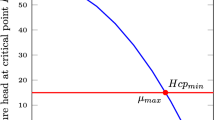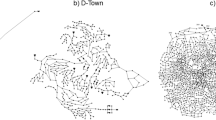Abstract
Critical infrastructures are becoming increasingly interdependent and vulnerable to cascading failures. Existing studies have analyzed the vulnerability of interdependent networks to cascading failures from the static perspective of network topology structure. This paper develops a more realistic cascading failures model that considers the dynamic redistribution of load in power network to explore the vulnerability of interdependent power-water networks. In this model, the critical tolerance threshold is originally proposed to indicate the vulnerability of network to cascading failures. In addition, some key parameters that are important to network vulnerability are identified and quantified through numerical simulation. Results show that cascading failures can be prevented when the values of tolerance parameter are above a critical tolerance threshold. Otherwise interdependent networks collapse after attacking a critical fraction of power nodes. Interdependent networks become more vulnerable with the increase in interdependence strength, which implies the importance of protecting those interconnected nodes to reduce the consequences of cascading failures. Interdependent networks are most vulnerable under high-load attack, which shows the significance of protecting high-load nodes.
Similar content being viewed by others
References
Albert, R., Albert, I. & Nakarado, G.L. (2004). Structural vulnerability of the North American power grid. Physical Review E, 69(2): 025103(R).
Albert, R., Jeong, H. & Barabási, A.L. (2000). Error and attack tolerance of complex networks. Nature, 406: 378–382.
Bagchi, A., Sprintson, A., Guikema, S., Bristow, E. & Brumbelow, K. (2010). Modeling performance of interdependent power and water networks during urban fire events. Paper presented at the 48th Annual Allerton Conference on Communication, Control, and Computing: 1637–1644.
Buldyrev, S.V., Parshani, R., Paul, G., Stanley, H.E. & Havlin, S. (2010). Catastrophic cascade of failures in interdependent networks. Nature, 464: 1025–1028.
Chang, S.E., McDaniels, T.L., Mikawoz, J. & Peterson, K. (2007). Infrastructure failure interdependencies in extreme events: power outage consequences in the 1998 Ice Storm. Natural Hazards, 41(2): 337–358.
Chen, X., Sun, K. & Cao, Y. (2007). Structural vulnerability analysis of large power grid based on complex network theory. Transactions of China Electro-technical Society, 22(10): 138–144.
Crucitti, P., Latora, V., Marchiori, M. & Rapisarda, A. (2003). Efficiency of scale-free networks: error and attack tolerance. Physica A: Statistical Mechanics and Its Applications, 320: 622–642.
de Bruijne, M. & van Eeten, M. (2007). Systems that should have failed: critical infrastructure protection in an institutionally fragmented environment. Journal of Contingencies and Crises Management, 15(1): 18–29.
Dorogovtsev, S.N., Goltsev, A.V. & Mendes, J.F.F. (2008). Critical phenomena in complex networks. Reviews of Modern Physics, 80(4): 1275–1335.
Dueñas-Osorio, L., Craig, J.I. & Goodno, B.J. (2007). Seismic response of critical interdependent networks. Earthquake Engineering & Structural Dynamics, 36(2): 285–306.
Eusgeld, I., Nan, C. & Dietz, S. (2011). “System-of-systems” approach for interdependent critical infrastructures. Reliability Engineering & System Safety, 96(6): 679–686.
Goh, K.-I., Kahng, B. & Kim D. (2001). Universal behavior of load distribution in scale-free networks. Physical Review Letters, 87(27): 278701.
Hernandez-Fajardo, I. & Dueñas-Osorio, L. (2011). Sequential propagation of seismic fragility across interdependent lifeline systems. Earthquake Spectra, 27(1): 23–43.
Holme, P., Kim, B.J., Yoon, C.N. & Han, S.K. (2002). Attack vulnerability of complex networks. Physical Review E, 65(5): 056109.
Huang, X., Gao, J., Buldyrev, S.V., Havlin, S. & Stanley, H.E. (2011). Robustness of interdependent networks under targeted attack. Physical Review E, 83(6): 065101(R).
Hwang, H., Lin, H. & Shinozuka, M. (1998). Seismic performance assessment of water delivery systems. Journal of Infrastructure Systems, 4(3): 118–125.
Jia, S.M., Wang, Y.Y. & Feng, C. (2014). Cascading failures in power grid under three node attack strategies. Intelligent Computing Methodologies, 8589: 779–786.
Johansson, J. & Hassel, H. (2010). An approach for modeling interdependent infrastructures in the context of vulnerability analysis. Reliability Engineering & System Safety, 95(12): 1335–1344.
Kinney, R., Crucitti, P. & Albert, R. (2005). Modeling cascading failures in the North American power grid. The European Physical Journal B, 46(1): 101–107.
Lan, Q., Zou, Y. & Feng, C. (2012). Cascading failure of power grids under three attack strategies. Chinese Journal of Computational Physics, 29(6): 943–948.
Latora, V. & Marchiori, M. (2001). Efficient behavior of small-world networks. Physical Review Letters, 87(19): 198701.
Lee, E.E., Mitchell, J.E. & Wallace, W.A. (2007). Restoration of services in interdependent infrastructure systems: a network flows approach. IEEE Transactions on Systems, Man, and Cybernetics, 37(6): 1303–1317.
Little, R.G. (2002). Controlling cascading failure: understanding the vulnerabilities of interconnected infrastructure. Journal of Urban Technology, 9(1): 109–123.
McDaniels, T., Chang, S., Peterson, K., Mikawoz, J. & Reed, D. (2007). Empirical framework for characterizing infrastructure failure interdependencies. Journal of Infrastructure Systems, 13(3): 175–184.
Motter, A.E. & Lai, Y.C. (2002). Cascade-based attacks on complex networks. Physical Review E, 66(6): 065102(R).
Newman, M.E.J. (2001). Scientific collaboration networks. II. Shortest paths, weighted networks, and centrality. Physical Review E, 64(1): 016132.
Ouyang, M., Hong, L., Mao, Z.J., Yu, M.H. & Qi, F. (2009). A methodological approach to analyze vulnerability of interdependent infrastructures. Simulation Modeling Practice and Theory, 17(5): 817–828.
Parshani, R., Buldyrev, S.V. & Havlin, S. (2010). Interdependent networks: reducing the coupling strength leads to a change from a first to second order percolation transition. Physical Review Letters, 105(4): 048701.
Restrepo, C.E., Simonoff, J.S. & Zimmerman, R. (2006). Unraveling geographic interdependencies in electric power infrastructure. Paper presented at the 39th Hawaii International Conference on Systems Sciences, Hawaii, USA.
Rinaldi, S., Peerenboom, J. & Kelly, T. (2001). Identifying, understanding, and analyzing critical infrastructure interdependencies. IEEE Control Systems Magazine, 21(6): 11–25.
Wang, J.W. & Rong, L.L. (2009). Cascade-based attack vulnerability on the US power grid. Safety Science, 47(10): 1332–1336.
Watts, D.J. & Strogatz, S.H. (1998). Collective dynamics of ‘small-world’ networks. Nature, 393(6684): 440–442.
Wu, J. & Dueñas-Osorio, L. (2013). Calibration and validation of a seismic damage propagation model for interdependent infrastructure systems. Earthquake Spectra, 29(3): 1021–1041.
Xu, X., Zhang, X. & Mendes, J.F.F. (2007). Impacts of preference and geography on epidemic spreading. Physical Review E, 76(5): 056109.
Zimmerman, R. & Restrepo, C.E. (2006). The next step: quantifying infrastructure interdependencies to improve security. International Journal of Critical Infrastructures, 2(2–3): 215–230.
Author information
Authors and Affiliations
Corresponding author
Additional information
Yanlu Zhang is a lecturer of School of Management, Northwestern Polytechnical Unversity, Xi’an, China. He received his PhD in management science and engineering from Northwestern Polytechnical University. His research interests focus on complex systems modeling and simulation, risk management of complex systems. He currently published many high-level papers in Reliability Engineering & System Safety, Safety Science, Systems Engineering — Theory & Practice, Chinese Journal of Management Science, etc.
Naiding Yang is a professor and doctoral mentor of School of Management, Northwestern Polytechnical University, Xi’an, China. He received his PhD in management science and engineering from Xi’an Jiaotong University. His research interests include management system engineering, risk management, decision analysis. He is the executive director of Emergency Management Institute of Northwestern Polytechnical University, and a member of Systems Engineering Society of China, Management Science and Engineering Society of China, Project Management Research Committee China, etc.
Upmanu Lall is the Alan and Carol Silberstein Professor of Engineering at Columbia University and the Director of the Columbia Water Center. He is a world-renowned expert in statistical and numerical modeling of hydrologic and climatic systems and water resource systems planning and management. His research areas include hydro-climatology, nonlinear dynamics, applied statistics, natural hazards, water systems and risk management, etc. He has pioneered statistical methods and their application to the prediction of hydrologic and climate conditions, and advanced tools for decision analysis and risk management.
Rights and permissions
About this article
Cite this article
Zhang, Y., Yang, N. & Lall, U. Modeling and simulation of the vulnerability of interdependent power-water infrastructure networks to cascading failures. J. Syst. Sci. Syst. Eng. 25, 102–118 (2016). https://doi.org/10.1007/s11518-016-5295-3
Published:
Issue Date:
DOI: https://doi.org/10.1007/s11518-016-5295-3




